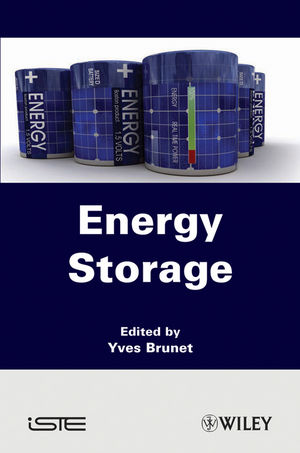Energy StorageISBN: 978-1-84821-183-4
Hardcover
272 pages
December 2010, Wiley-ISTE
 |
||||||
Foreword x
Yves BRUNET
Chapter 1. Energy Storage for Electrical Systems 1
Régine BELHOMME, Jérôme DUVAL, Gauthier DELLILE,
Gilles MALARANGE, Julien MARTIN and Andrei NEKRASSOV
1.1. Introduction 1
1.2. Energy storage for the producer 3
1.3. The special case of intermittent generation 8
1.4. Energy storage for transmission systems 13
1.5. Energy storage for distribution networks 16
1.6. Energy storage for retailers 22
1.7. Energy storage for consumers 23
1.8. Energy storage for the balancing responsible party (BRP) 28
1.9. Conclusion 31
1.10. Bibliography 34
Chapter 2.Transport: Rail, Road, Plane, Ship 37
Jean-Marie KAUFFMANN
2.1. Introduction 37
2.2. Electrical energy is a secondary energy 38
2.3. Electrical energy: principal or unique source 43
2.4. Electrical energy complementing another source – hybridization 55
2.5. Conclusion 61
2.6. Bibliography 63
Chapter 3. Energy Storage in Photovoltaic Systems
65
Florence MATTERA
3.1. Introduction 65
3.2. Stand alone photovoltaic systems 65
3.3. Limited lifespan for lead acid battery technology 72
3.4. Grid connected systems 77
3.5. Bibliography 81
Chapter 4. Mobile Applications and Micro-Power Sources
83
Jérôme DELAMARE and Orphée CUGAT
4.1. The diverse energy needs of mobile applications 83
4.2. Characteristics due to the miniaturized scale 89
4.3. Capacitative storage 90
4.4. Electrochemical storage 91
4.5. Hydrocarbon storage 95
4.6. Pyroelectricity 102
4.7. Tribo-electricity 102
4.8. Radioactive source 103
4.9. Recovering ambient energy 103
4.10. Associated electronics: use of electricity – onboard EP 106
4.11. Bibliography 107
Chapter 5. Hydrogen Storage 115
Daniel FRUCHART
5.1. Introduction 115
5.2. Generalities regarding hydrogen storage 116
5.3. Pressurized storage 119
5.4. Cryogenic storage 121
5.5. Solid storage 122
5.6. Other modes of storage 128
5.7. Discussion: technical/energy/economic aspects 129
5.8. Bibliography 131
Chapter 6. Fuel Cells: Principles and Function 133
Eric VIEIL
6.1. What is a cell or battery? 133
6.2. Chemical energy 134
6.3. The unfolding of a reaction 137
6.4. Proton-exchange membrane fuel cells (PEMFCs) 143
6.5. The solid oxide fuel cell (SOFC) 143
6.6. The alkaline fuel cell (AFC) 145
6.7. Comparison of the different types of fuel cell 146
6.8. Catalysis 148
6.9. Critical points 149
6.10. Conclusion: the storage application 151
Chapter 7. Fuel Cells: System Operation 153
Daniel HISSEL, Denis CANDUSSO and Marie-Cécile PERA
7.1. Introduction: what is a fuel cell “system”? 153
7.2. Air supply system 156
7.3. Gas humidification system 160
7.4. The static converter at the stack terminals 164
7.5. Lifespan, reliability and diagnosis 165
7.6. Bibliography 170
Chapter 8. Electrochemical Storage: Cells and Batteries
173
Florence FUSALBA and Sébastien MARTINET
8.1. Generalities of accumulators: principle of operation 173
8.2. Applications 176
8.3. Technological histories: lead, Ni-Cd, Ni-MH… then lithium ion 185
8.4. Application needs 197
8.5. Focusing on lithium-ion technologies 199
8.6. Processing and recycling of lithium batteries 207
8.7. Other batteries 209
8.8. Bibliography 214
Chapter 9. Supercapacitors: Principles, Sizing, Power
Interfaces and Applications 217
Philippe BARRADE
9.1. Introduction 217
9.2. Supercapacitor: electric double-layer capacitor 219
9.3. Sizing a bank of supercapacitors 226
9.4. Power interfaces 230
9.5. Applications 235
9.6. Bibliography 240
List of authors 243
Index 245



